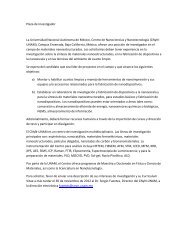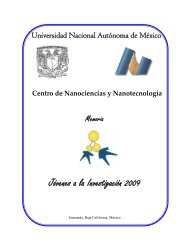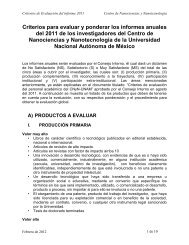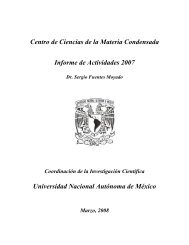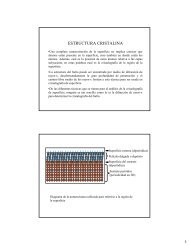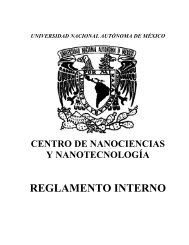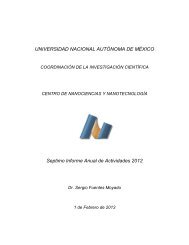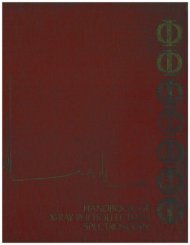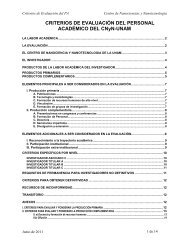Universidad Nacional Autónoma de México - CNyN
Universidad Nacional Autónoma de México - CNyN
Universidad Nacional Autónoma de México - CNyN
Create successful ePaper yourself
Turn your PDF publications into a flip-book with our unique Google optimized e-Paper software.
1st International Symposium on Nanoscience and Nanomaterials<br />
practical interest. The wi<strong>de</strong> range of applications of carbon nano-fibers have been <strong>de</strong>rived from its<br />
characteristics such as high heat resistance, high mechanical strength, inert chemical (corrosion), and<br />
biocompatibility, having a large range of application coverage in general industry to the aerospace and<br />
medicine. In this work we report a novel method to grow carbon nanofibers on Si wafers by Chemical Vapor<br />
Deposition (CVD) in a three-zone horizontal quartz tube reactor. UHP methane (CH 4 ) and UHP hydrogen<br />
(H 2 ) where used as precursors. Methane and hydrogen are introduced in the reactor where they are combined<br />
with ammonia (NH 3 ) at the following conditions: pressure = 22 Torr, temperature at zone 1 = 1200 °C,<br />
temperature at zone 2 = 900 °C and temperature at zone 3 = 520 °C, the flux were CH 4 = 10 sccm, NH 3 = 30<br />
sccm and H 2 = 380 sccm during one hour of <strong>de</strong>posit. At these conditions the methane discomposes to yield<br />
carbon nanofibers. The fibers obtained were analyzed by XPS, IR, SEM, TEM and XRD. The results<br />
indicated that this novel method can be used to produce large quantities of high quality carbon nano-fibers in<br />
short time and low cost.<br />
P-003<br />
EFFECTS ANNEALING ATMOSPHERE ON STRUCTURAL, OPTICAL AND ELECTRICAL<br />
PROPERTIES OF ZnO THIN FILMS<br />
H. Juárez 1,a , M. Pacio 1 , C. Bueno 1 , R. Perez 1 , G. Juárez 1 , E. Vargas 1 , M. Rodríguez 1 , T. Diaz 1 .<br />
1 CIDS-ICUAP, Benemérita <strong>Universidad</strong> Autónoma <strong>de</strong> Puebla, 14 Sur y Av. San Claudio, C.U., Edif. 103C,<br />
C.P. 72750, Pue., Puebla,<br />
Keywords: Zinc Oxi<strong>de</strong>.<br />
1a hjuarez@cs.buap.mx<br />
ZnO films were obtained by the sol-gel method utilizing zinc acetate dihydrate as the precursor of<br />
the Zn atom, monoethanolamine (MEA) as a stabilizing agent and 2-methoxyethanol as a solvent. The ZnO<br />
films were <strong>de</strong>posited on p-Si substrates via spin-coating technique. The gel film was stabilized by pre-heating<br />
at 300 ºC. This procedure was repeated 10 times. After, the films were crystallized by an annealing at 600 ºC<br />
in Oxygen, Ozone and Nitrogen atmosphere. The optical and structural properties of the ZnO films <strong>de</strong>pend on<br />
the annealing temperature and the atmosphere type. These conditions also affect the properties of the n-<br />
ZnO/p-Si heterostructure. The X-ray diffraction patterns shown that all the films have (002) preferential<br />
orientation and the photoluminescence measurements show emission that corresponding to the UV and visible<br />
region. UV-Vis spectroscopy was used to <strong>de</strong>termine the reflectivity and the band gap of the ZnO films. The<br />
electrical properties were obtained by I-V curves of the n-ZnO/p-Si heterostructure. Finally shows that the<br />
structural, optical and electrical properties have correlation with the annealing atmosphere.<br />
P-004<br />
PORE SIZE DISTRIBUTION IN ZEOLITES WITH RINGS 8, 10 AND 12 PARTS: LTA, ERI, HEU,<br />
ZSM5, MOR, FAU<br />
Vázquez Tobón Olga A. 1,a , Hernán<strong>de</strong>z Espinoza Miguel A. 2,b<br />
1 Colegio <strong>de</strong> Ingeniería en Materiales, Facultad <strong>de</strong> Ingeniería Química, BUAP; Puebla, México<br />
2 Departamento <strong>de</strong> Investigación en Zeolitas y Posgrado en Ciencias Ambientales, Instituto <strong>de</strong> Ciencias,<br />
BUAP; Puebla, México<br />
24




